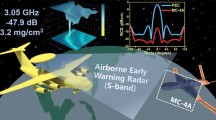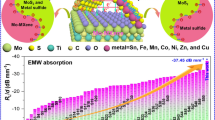Abstract
The NiFe2O4 (NFO) assembly was synthesized via thermal decomposition in a gradient magnetic field, and its structure, composition, as well as magnetic and electromagnetic absorption properties were investigated. The applied magnetic field adjusts the size of nanoparticles, the magnetic properties change correspondingly. The saturation magnetic intensity increases from 54.21 emu/g to 61.67 emu/g, however, the coercivity changes less, and Hc is in the range of 32.75–34.01 Oe. Simultaneously, the XPS results suggest that an increase in oxygen vacancies with addition of magnetic field. With the magnetic field application, a higher complex permittivity and more excellent microwave absorption performance are achieved. With the application of magnetic field, the nanoparticles become smaller, and more interfaces are generated, the interfacial polarisation effect is strengthened. Simultaneously, the applied magnetic field also leads to an increase in oxygen vacancies. Therefore, dielectric loss values are enhanced. Moreover, the reflection loss was optimized to − 14.32 dB with a matching thickness of 5.5 mm when the sample prepared under magnetic field 0.32 T. The above results prove that the magnetic field can be used as an effective route to achieve excellent microwave performance for NFO.











Similar content being viewed by others
Data availability
The datasets generated during and/or analyzed during the current study are available from the corresponding author on reasonable request.
References
W. Wu, C. Yu, J. Chen, Q. Yang, Int. J. Environ. Anal. Chem. 100, 324–332 (2020)
C. Luo, T. Jiao, Y. Tang, J. Kong, Adv. Eng. Mater. 20, 1701168 (2018)
H. Lv, Z. Yang, P.L. Wang, G. Ji, J. Song, L. Zheng, H. Zeng, Z.J. Xu, Adv. Mater. 30, 1706343 (2018)
J.L. Gunjakar, A.M. More, K.V. Gurav, C.D. Lokhande, Appl. Surf. Sci. 254, 5844–5848 (2008)
L. Chen, H. Dai, Y. Shen, J. Bai, J. Alloys Compd. 491, L33–L38 (2010)
D.S. Mathew, R.S. Juang, Chem. Eng. J. 129, 51–65 (2007)
D.I. Sharifi, H. Shokrollahi, S. Amiri, J. Magn. Magn. Mater. 324, 903–915 (2012)
M.R. Phadatare, V.M. Khot, A.B. Salunkhe, N.D. Thorat, S.H. Pawar, J. Magn. Magn. Mater. 324, 770–772 (2012)
S. Prabhu, M. Geerthana, S. Sohila, G.M. Bhalerao, S. Harish, M. Navaneethan, Y. Hayakawa, R. Ramesh, J. Supercond. Nov. Magn. 32, 1423–1429 (2019)
T. Giannakopoulou, L. Kompotiatis, A. Kontogeorgakos, G. Kordas, J. Magn. Magn. Mater. 246, 360–365 (2002)
S.V. Bangale, D.R. Patil, S.R. Bamane, Arch. Appl. Sci. Res. 3, 506–513 (2011)
V. Šepelák, D. Baabe, D. Mienert, D. Schultze, F. Krumeich, F.J. Litterst, K.D. Becker, J. Magn. Magn. Mater. 257, 377–386 (2003)
C. Srinivas, B.V. Tirupanyam, A. Satish, V. Seshubai, D.L. Sastry, O.F. Caltun, J. Magn. Magn. Mater. 382, 15–19 (2015)
W. Lin, Z. Wang, Mater. Lett. 352, 135212 (2023)
G. Liang, F. Han, X. Ye, X. Meng, Mater. Sci. Eng. B 289, 116224 (2023)
B. Bateer, J. Zhang, H. Zhang, X. Zhang, C. Wang, H. Qi, J. Electron. Mater. 47, 292–298 (2018)
Y. Chen, P. Zhu, M. Duan, J. Li, Z. Ren, P. Wang, Appl. Surf. Sci. 486, 198–211 (2019)
H. Liu, M. Zhang, K. Hu, X. Kong, Q. Li, Q. Liu, J. Mater. Sci. Mater. Electron. 32, 26021–26033 (2021)
S. Golchinvafa, S.M. Masoudpanah, S. Alamolhoda, Ceram. Int. 49, 18134–18142 (2023)
H. Liu, M. Zhang, Y. Ye, J. Yi, Y. Zhang, Q. Liu, J. Alloys Compd. 892, 162126 (2022)
P. Yang, Y. Liu, X. Zhao, C. Zhang, J. Mater. Sci. Mater. Electron. 28, 9867–9875 (2017)
X. Zhang, X. Kan, M. Wang, R. Rao, G. Zheng, M. Wang, Y. Ma, J. Cryst. Growth 565, 126131 (2021)
W. Ding, L. Hu, J. Dai, X. Tang, R. Wei, Z. Sheng, C. Liang, D. Shao, W. Song, Q. Liu, M. Chen, X. Zhu, S. Chou, X. Zhu, Q. Chen, Y. Sun, S.X. Dou, ACS Nano 13, 1694–1702 (2019)
G. Helgesen, A.T. Skjeltorp, P.M. Mors, R. Botet, R. Jullien, Phys. Rev. Lett. 61, 1736 (1988)
P. Kumar, R. Kumar, H.N. Lee, Thin Solid Films 592, 155–161 (2015)
Z. Kou, E. Liu, J. Yue, Y. Sui, Z. Huang, D. Zhang, Y. Wang, Y. Zhai, J. Du, H. Zhai, J. Appl. Phys. 117, 17E709 (2015)
Z. Yang, M. Li, Y. Zhang, X. Lyu, D. Hu, J. Alloys Compd. 781, 321–329 (2019)
S. Moosavi, S. Zakaria, C.H. Chia, S. Gan, N.A. Azahari, H. Kaco, Ceram. Int. 43, 7889–7894 (2017)
R.S. Yadav, I. Kuřitka, J. Vilcakova, J. Havlica, J. Masilko, L. Kalina, J. Tkacz, V. Enev, M. Hajdúchová, J. Phys. Chem. Solids 107, 150–161 (2017)
W.P. Wp, H. Yang, T. Xian, J.L. Jiang, Mater. Trans. 53, 1586–1589 (2012)
Z. Zhou, Y. Zhang, Z. Wang, W. Wei, W. Tang, J. Shi, R. Xiong, Appl. Surf. Sci. 254, 6972–6975 (2008)
J.F. Marco, J.R. Gancedo, M. Gracia, J.L. Gautier, E. Ríos, F.J. Berry, J. Solid State Chem. 153, 74–81 (2000)
Y. Zou, H. Wang, R. Yang, X. Lai, J. Wan, G. Lin, D. Liu, Sens. Actuators B: Chem. 280, 227–234 (2019)
X. Wang, K. Fu, X. Wen, S. Qi, G. Tong, X. Wang, W. Wu, Appl. Surf. Sci. 598, 153826 (2022)
N. Song, S. Gu, Q. Wu, C. Li, J. Zhou, P. Zhang, W. Wang, M. Yue, J. Magn. Magn. Mater. 451, 793–798 (2018)
X. Liang, C. Wang, M. Yu, S. Liu, Y. Zhang, S. Zhong, J. Mater. Sci. Mater. Electron. 34, 31 (2023)
X. Chen, Y. Wang, H. Liu, S. Jin, G. Wu, J. Colloid Interface Sci. 606, 526–536 (2022)
H. Liang, G. Chen, D. Liu, Z. Li, S. Hui, J. Yun, L. Zhang, H. Wu, Adv. Funct. Mater. 33, 2212604 (2023)
N.N. Song, H.T. Yang, X. Ren, Z.A. Li, Y. Luo, J. Shen, W. Dai, X.Q. Zhang, Z.H. Cheng, Nanoscale 5, 2804–2810 (2013)
Y. Wang, X. Di, X. Wu, X. Li, J. Alloys Compd. 846, 156215 (2020)
M. Akyol, C. Aka, O. İnözü, F.Ö. Alkurt, M. Karaaslan, J. Mater. Sci. Mater. Electron. 34, 544 (2023)
B. Wang, Y. Ji, C. Mu, Y. Huo, J. Xiang, A. Nie, F. Wen, Appl. Surf. Sci. 591, 153176 (2022)
H. Yan, Y. Guo, X. Bai, J. Qi, X. Zhao, H. Lu, L. Deng, Appl. Surf. Sci. 633, 157602 (2023)
M. Mehdipour, H. Shokrollahi, J. Appl. Phys. 114, 043906 (2013)
H. Wu, S. Qu, K. Lin, Y. Qing, L. Wang, Y. Fan, Q. Fu, F. Zhang, Powder Technol. 333, 153–159 (2018)
Acknowledgements
This work was supported by the National Key Research and Development Program of China (No. 2021YFA1600203), the National Natural Science Foundation of China (Grant No. U19A2093), and the Open Fund for Discipline Construction, Institute of Physical Science and Information Technology, Anhui University.
Funding
The work was supported by The National Key Research and Development Program of China, No. 2021YFA1600203, GanHong Zheng, The National Natural Science Foundation of China, Grant No. U19A2093
Author information
Authors and Affiliations
Contributions
All authors contributed to the study conception and design. Material preparation, data collection, and analysis were performed by YZ, DH, WM, and ZC. The first draft of the manuscript was written by ZG and all authors commented on previous versions of the manuscript. This manuscript was guided by DZ and DW. All authors read and approved the final manuscript.
Corresponding author
Ethics declarations
Conflict of interest
The authors declare that they have no conflict of interest.
Additional information
Publisher's Note
Springer Nature remains neutral with regard to jurisdictional claims in published maps and institutional affiliations.
Supplementary Information
Below is the link to the electronic supplementary material.
Rights and permissions
Springer Nature or its licensor (e.g. a society or other partner) holds exclusive rights to this article under a publishing agreement with the author(s) or other rightsholder(s); author self-archiving of the accepted manuscript version of this article is solely governed by the terms of such publishing agreement and applicable law.
About this article
Cite this article
Yun, Z., Zheng, G., Dong, H. et al. The microwave absorption performance of NiFe2O4 prepared under the gradient magnetic field. J Mater Sci: Mater Electron 35, 936 (2024). https://doi.org/10.1007/s10854-024-12638-w
Received:
Accepted:
Published:
DOI: https://doi.org/10.1007/s10854-024-12638-w




